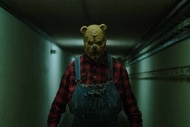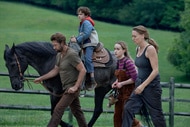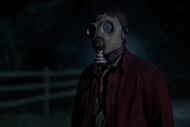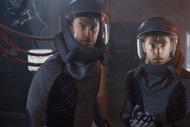Create a free profile to get unlimited access to exclusive videos, sweepstakes, and more!
Director Francis Lawrence helps 'See' the future on Apple TV+
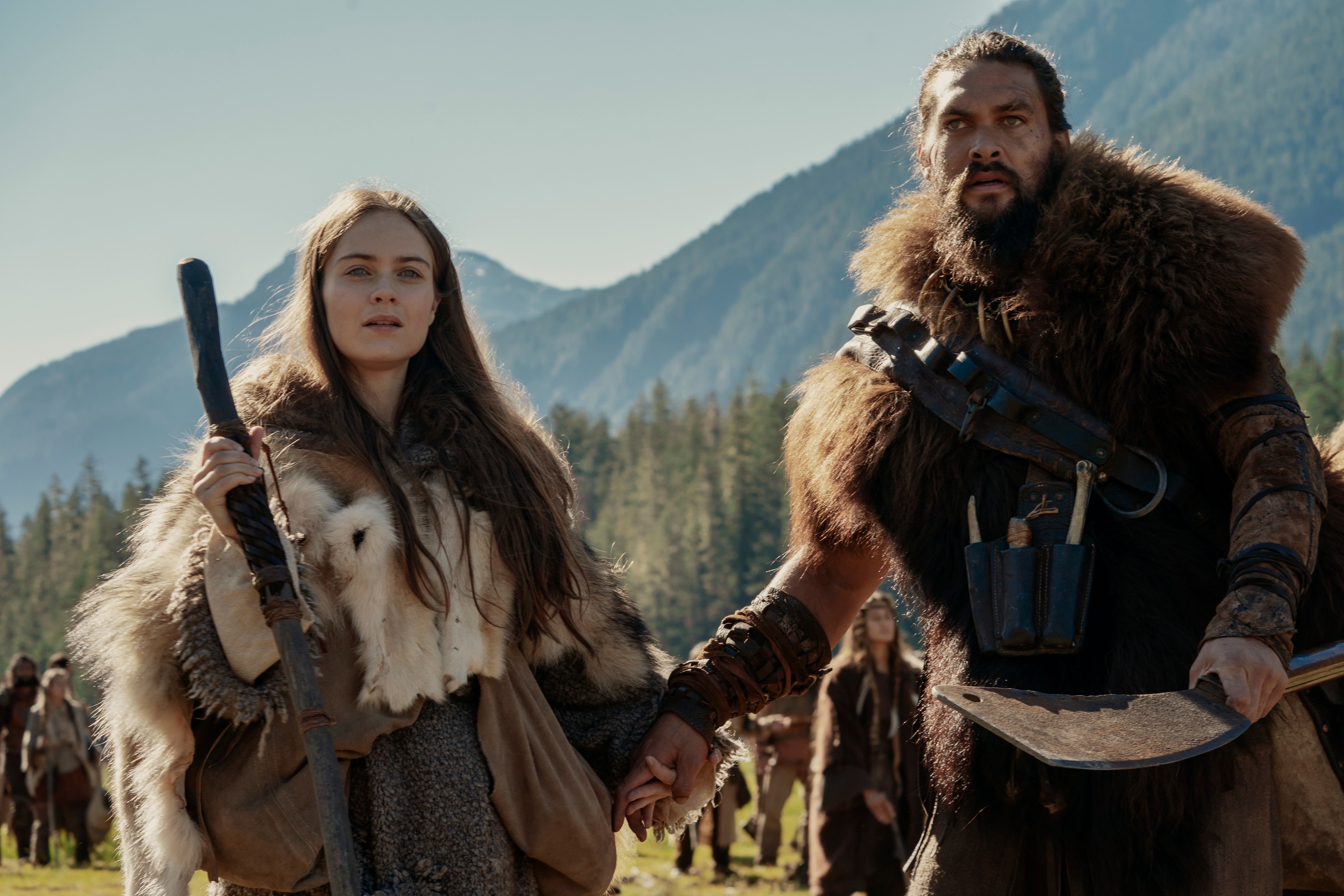
In Francis Lawrence's twenty-plus years as a director, television hasn't grabbed his creative attention very much. He's done almost 100 ultra cinematic music videos for artists such as Janet Jackson, Beyonce and Garbage, and memorable genre films from Constantine to three The Hunger Games films with Jennifer Lawrence (no relation). But in the TV space, he's only directed two pilots — Kings (2009) and Touch (2012), and at the time, that was plenty.
"My experience in network TV was never all that great in terms of budget size and the parameters of the timings of episodes and the commercial breaks," Lawrence tells SYFY WIRE about his prior frustrations with the medium.
But his experience with the spy thriller, Red Sparrow set the stage for his attention to suddenly shift to streaming networks. "Red Sparrow did not work theatrically," he says with candor. "We got by, but it's not something I would ever make theatrically now. Now, would I do it again if it came across my desk for streaming? 100%."
Recognizing the shift in the market for storytelling that will never get greenlit for theatrical release, but embraced for streaming, Lawrence joined executive producer Steven Knight (Peaky Blinders) to pitch Apple TV+ the big-budget speculative, post-apocalyptic drama, See.
"The show itself I thought was very creative, very unique and I loved the voice. I love Steve Knight's work," he explains. "I just responded to the script. And you know, I love world-building, and it has plenty of that to do, which was exciting. And the truth is that TV, to me, has become more exciting with the streaming platforms. I think that there is much more opportunity with interesting storytelling now."
Lawrence sat down with us to explain how he's taken his cinematic visuals and ironically helped establish a world 600-years in the future where humans can no longer see.
Was the big sell for you to work with Apple TV+ on See that they wanted you to go big, and not compromise for TV what would typically be more of a cinematic approach to this kind of storytelling?
Yeah, this was much more of a cinematic experience. When we sold the show to Apple, I knew they wanted to make something much more visual, more cinematic and do things differently. So, it felt fairly close to a cinematic experience on my end, on the production side and the development side.
The show posits our world after a virus wipes out much of humanity, and the survivors are then left blind. There's an actual scientific evolution you could track in that outcome, so how much of this is based in reality and how much is just speculative fiction?
There's two sides of it. One is something that was similar territory to I Am Legend, in that you have this viral apocalypse that kills off most, if not all, of society. What happened? Nature starts to reclaim. I Am Legend was three years after the fact. This is hundreds of years after the fact. So you have this nature reclaiming civilization as we know it element, and that was fun.
Then the other guiding principle that was the biggest element of this show for us in terms of design and world-building is the blindness. Because anything we build, whether it's a costume, a prop, a hut, a set, anything like that, you need to be thinking about it from the blindness perspective, because these are people who have evolved for 600 years. How are they navigating? What's the behavior like? Why do they need furniture? How do you lay it out? Because nothing would be done for aesthetic reasons. It would be all practical reasons and for other senses: for smell, touch, taste, and audio. So that was really where the bulk of the world-building came in, figuring out and brainstorming all of the possibilities that we had at our fingertips. We put think tanks together and worked with experts and blindness consultants. We had a blindness consultant on set with us every day, to learn and brainstorm how people could possibly do things in this world we've created.
How did you go about creating a unique experience for us so we empathize with how this future world might really feel?
What's interesting is that at the core of this, as in any good science fiction, you'd need a relatable emotional story. I think we have a relatable emotional story. You've got this family that loves one another and they're trying to protect one another, and that we can relate to. The world you can't relate to, that becomes weirdly just part of the tapestry of the show.
Now, it's part of the show that we had to work a lot at. We had to put tons of thought into it. We had to put together a very intensive boot camp for the actors, and for some of the crew. But the truth is, you're not supposed to think about the fact that they're all blind all the time. Inevitably, you will in the beginning and then it should fall away and become a part of the fabric of the show. You should be ideally in love with the characters and empathizing with the characters just as human beings.
You attracted a film quality cast for See. How did you snag someone like Jason Mamoa who is having a moment now post Aquaman?
Jason is the first person that we cast and it was so clear there was really nobody else that could play Baba Voss. Just in terms of the size, the physicality. The aggression, at times. The vulnerability and warmth, the humor that comes out every once in a while, and the alpha maleness of him as the leader of the village. It was very lucky for us that he responded to the script and wanted to do it, and the timing worked out. Because honestly, we didn't have any second choices. I don't know what we would have done. Then Alfre (Woodard), I think we brought her in next, and then there's other characters, like Hera Hilmar, who played Maghra, and Sylvia Hoeks as Queen Kane.
Was a lot of cast new collaborators because you do tend to work with certain actors repeatedly?
Yes, I had not known Hera's work, but she read for the part of Maghra. She was one of the first people that read. We brought her in very quickly. Sylvia, who I'd seen in Blade Runner 2049, she read for the part and instantly it was like, 'Okay, that's definitely the queen.' A lot of people were just brought in, so a lot were discoveries for me. People like Archie (Madekwe) and Nesta (Cooper). We got a good group of talented people. Very diverse, which was fun and exciting.
It is a very diverse cast. By design?
If you have people who can't see, ethnicity's not going to matter anymore. Prejudice still will be there but for different reasons and ethnicity wouldn't be one. So that was an interesting idea that Steven and I talked about early on, which led to quite a diverse cast.
What was your approach in crafting a first season? How episodic versus how standalone to go with a show that is so high concept?
Steve had very specific ideas going in, because when I came on board, there were two scripts. He pitched to me the general idea for the rest of the season, and where other seasons could go. So, it's pitched as a continuing story. I think what interested me specifically about the pilot was that I found it very unique for TV. You're dropped in and things are happening. You're in the middle of something and you're catching up in a great way. It's not until episode two where you start to settle in for a bit and get to go, 'Okay, now I think I have a sense of who people are and what the dynamics are and what the relationships are.' But that's the thing that I love about the pilot is that it just doesn't feel set up.
You're listed as the director for the first three episodes which really establish the look and tone of the series. Was there a big discussion about how many you would direct?
Originally, I thought that I wanted to do all the episodes. The idea of that was really nice. Then I saw the outline for the season and I went, 'There's no waythat I could do the whole season.' I decided I'd do three, which was a lot, and prep was equivalent of a large feature.
As an executive producer/director, how have you stayed connected post directing?
I helped hire the other directors that came on. I would talk to the alternate cinematographer and talk to the directors and have lots of meetings. And I was always available for the actors. I wanted to make sure that the visual approach stayed the same, that the location choices stayed the same.
What's one of your favorite sequences you directed for See?
I have to say one of my favorite moments in the show, and it wasn't necessarily my favorite to shoot, but it's one of my favorite moments in the show is in the first episode when we finally go and meet the queen. I think Sylvia is great in the role, but I also think that because you've been in this world for about 40 minutes by the time you get there, you think you know the show. Then you follow this bird and you fly into the dam and you meet this woman and suddenly Lou Reed is playing on the record player and here's this completely different character in a completely different environment. To me, it just opens the show up like, 'Oh wow, there's way more to the show than I thought!' And that feeling, I really, really love.
As a cinematic director, does it bother you that a lot of people might be watching your series on a tablet or a phone instead of a big screen?
The great thing with Apple is I went in and I said, 'Look, I'm going to shoot this large format and that'll be great for your Apple TVs and emerging technologies and high dynamic range and all that. But let's do some one-off IMAX screenings.' They were like, 'Great!' So now we're going to have IMAX screenings and kids will watch it on their iPhones. That's fine by me. I don't mind that.
It doesn't make you wince even a little that so much will get lost in the tech translation?
I want to make stuff that people watch and I don't want to just be limited by saying, 'I will only work if it's a theatrical release.' I just think that's ridiculous. Truthfully, I also love it because I love the process. If I love the project and it's creative and it's unique and I feel like I can sink my teeth in, then it's great. If people are going to watch it, even better. The worst thing in the world is nobody watching.
See is available on Apple TV+ starting November 1.


